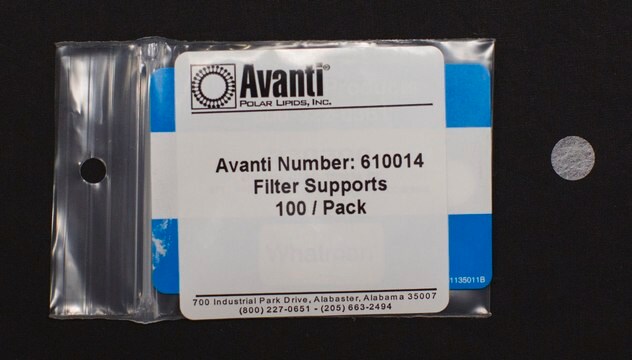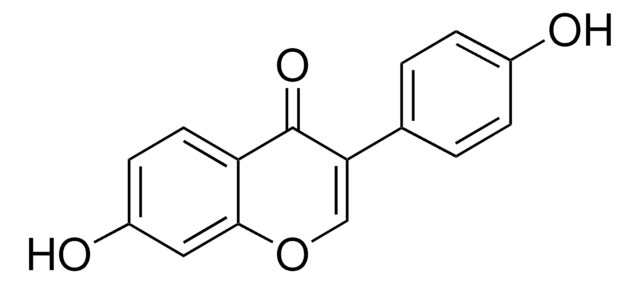40692
Atto 532 DOPE
suitable for fluorescence
Sinonimo/i:
1,2-Dioleoyl-sn-glycero-3-phosphoethanolamine labeled with Atto 532
Autenticatiper visualizzare i prezzi riservati alla tua organizzazione & contrattuali
About This Item
Codice UNSPSC:
12352108
NACRES:
NA.32
Prodotti consigliati
Saggio
≥80.0% (HPCE)
Produttore/marchio commerciale
ATTO-TEC GmbH
Fluorescenza
λex 537 nm; λem 559 nm±5 nm in ethanol
Compatibilità
suitable for fluorescence
Temperatura di conservazione
−20°C
Descrizione generale
Atto 532 is a fluorescent label related to the well-known dye Rhodamine 6G. Characteristic features of the label are strong absorption, high fluorescence quantum yield, high photostability, and excellent water solubility. Thus Atto 532 is highly suitable for single-molecule detection applications and high-resolution microscopy such as PALM, dSTORM, STED etc. Additionally the dye highly qualifies to be applied in flow cytometry (FACS), fluorescence in-situ hybridization (FISH) and many more. The fluorescence is excited most efficiently in the range 515 - 545 nm.
A suitable excitation source for Atto 532 is the 532 nm output of the frequency-doubled Nd:YAG laser.
Atto-Dye Labeled Phospholipids
Sigma-Aldrich offers a variety of glycero-phospholipids carrying one or two fatty acid groups (lipophilic groups) and a phosphate ester residue (hydrophilic group). They are labeled at the hydrophilic head group. After incorporation of the phospholipid into a membrane the fluorophore is located at the water/lipid interface of the membrane. We currently provide 1,2-dipalmitoyl-sn-glycero-3-phosphoethanolamine (DPPE), 1,2-dioleoyl-sn-glycero-3-phosphoethanolamine (DOPE), palmitoyl-sn-glycero-phosphoethanolamine (PPE), and 1,2-dimyristoyl-sn-glycero-3-phospho-ethanolamine (DMPE) labeled with Atto-dyes.
find more information here
A suitable excitation source for Atto 532 is the 532 nm output of the frequency-doubled Nd:YAG laser.
Atto-Dye Labeled Phospholipids
Sigma-Aldrich offers a variety of glycero-phospholipids carrying one or two fatty acid groups (lipophilic groups) and a phosphate ester residue (hydrophilic group). They are labeled at the hydrophilic head group. After incorporation of the phospholipid into a membrane the fluorophore is located at the water/lipid interface of the membrane. We currently provide 1,2-dipalmitoyl-sn-glycero-3-phosphoethanolamine (DPPE), 1,2-dioleoyl-sn-glycero-3-phosphoethanolamine (DOPE), palmitoyl-sn-glycero-phosphoethanolamine (PPE), and 1,2-dimyristoyl-sn-glycero-3-phospho-ethanolamine (DMPE) labeled with Atto-dyes.
find more information here
Note legali
This product is for Research use only. In case of intended commercialization, please contact the IP-holder (ATTO-TEC GmbH, Germany) for licensing.
Codice della classe di stoccaggio
11 - Combustible Solids
Classe di pericolosità dell'acqua (WGK)
WGK 3
Punto d’infiammabilità (°F)
Not applicable
Punto d’infiammabilità (°C)
Not applicable
Scegli una delle versioni più recenti:
Possiedi già questo prodotto?
I documenti relativi ai prodotti acquistati recentemente sono disponibili nell’Archivio dei documenti.
Breaking the diffraction barrier in fluorescence microscopy at low light intensities by using reversibly photoswitchable proteins.
Hofmann, M.; et al.
Proceedings of the National Academy of Sciences of the USA, 102(49), 17565?17569-17565?17569 (2005)
Technical Review. Types of Imaging-Direct STORM.
Jensen, E.; Crossman, D. J.
The Anatomical Record, 297(12), 2227-2231 (2014)
Stimulated emission depletion-based raster image correlation spectroscopy reveals biomolecular dynamics in live cells.
Hedde P.N.; et al.
Nature Communications, 4, 2093-2093 (2013)
Munc18-1 Tuning of Vesicle Merger and Fusion Pore Properties.
Jorgacevski, J.; et al.
The Journal of Neuroscience, 31(24), 9055-9066 (2011)
SNARE Function Is Not Involved in Early Endosome Docking.
Geumann, U.; et al.
Molecular Biology of the Cell, 19(12), 5327-5337 (2008)
Il team dei nostri ricercatori vanta grande esperienza in tutte le aree della ricerca quali Life Science, scienza dei materiali, sintesi chimica, cromatografia, discipline analitiche, ecc..
Contatta l'Assistenza Tecnica.





